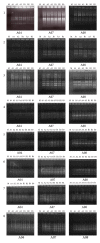Clonality Analysis of Helicobacter pylori in Patients Isolated from Several Biopsy Specimens and Gastric Juice in a Japanese Urban Population by Random Amplified Polymorphic DNA Fingerprinting
- PMID: 24348543
- PMCID: PMC3855995
- DOI: 10.1155/2013/721306
Clonality Analysis of Helicobacter pylori in Patients Isolated from Several Biopsy Specimens and Gastric Juice in a Japanese Urban Population by Random Amplified Polymorphic DNA Fingerprinting
Abstract
Background. The number of Helicobacter pylori clones infecting a single host has been discussed in numerous reports. The number has been suggested to vary depending on the regions in the world. Aim. The purpose of this study was to examine the number of clones infecting a single host in a Japanese urban population. Materials and Methods. Thirty-one Japanese patients undergoing upper gastrointestinal endoscopy were enrolled in this study. H. pylori isolates (total 104 strains) were obtained from biopsy specimens (antrum, corpus, and duodenum) and gastric juice. Clonal diversity was examined by the random amplified polymorphic DNA (RAPD) fingerprinting method. Results. The RAPD fingerprinting patterns of isolates from each patient were identical or very similar. And the isolates obtained from several patients with 5- to 9-year intervals showed identical or very similar RAPD patterns. Conclusion. Each Japanese individual of an urban population is predominantly infected with a single H. pylori clone.
Figures


Similar articles
-
High prevalence of multiple strain colonization of Helicobacter pylori in Korean patients: DNA diversity among clinical isolates from the gastric corpus, antrum and duodenum.Korean J Intern Med. 2004 Mar;19(1):1-9. doi: 10.3904/kjim.2004.19.1.1. Korean J Intern Med. 2004. PMID: 15053036 Free PMC article.
-
Predominance of a single strain of Helicobacter pylori in gastric antrum.Helicobacter. 1999 Mar;4(1):28-32. doi: 10.1046/j.1523-5378.1999.09043.x. Helicobacter. 1999. PMID: 10352084
-
Isolation of a single strain of Helicobacter pylori from the antrum and body of individual patients.Eur J Gastroenterol Hepatol. 2000 Oct;12(10):1129-34. doi: 10.1097/00042737-200012100-00010. Eur J Gastroenterol Hepatol. 2000. PMID: 11057459
-
Molecular diagnosis of Helicobacter pylori.Immunol Invest. 1997 Jan-Feb;26(1-2):163-74. doi: 10.3109/08820139709048924. Immunol Invest. 1997. PMID: 9037621 Review.
-
Population Genetics.In: Mobley HLT, Mendz GL, Hazell SL, editors. Helicobacter pylori: Physiology and Genetics. Washington (DC): ASM Press; 2001. Chapter 32. In: Mobley HLT, Mendz GL, Hazell SL, editors. Helicobacter pylori: Physiology and Genetics. Washington (DC): ASM Press; 2001. Chapter 32. PMID: 21290736 Free Books & Documents. Review.
Cited by
-
High-resolution mapping reveals that microniches in the gastric glands control Helicobacter pylori colonization of the stomach.PLoS Biol. 2019 May 2;17(5):e3000231. doi: 10.1371/journal.pbio.3000231. eCollection 2019 May. PLoS Biol. 2019. PMID: 31048876 Free PMC article.
-
The analysis of virulence factors and antibiotic resistance between Helicobacter pylori strains isolated from gastric antrum and body.BMC Gastroenterol. 2019 Aug 7;19(1):140. doi: 10.1186/s12876-019-1062-5. BMC Gastroenterol. 2019. PMID: 31390989 Free PMC article.
-
Heterogeneity of Helicobacter pylori Strains Isolated from Patients with Gastric Disorders in Guiyang, China.Infect Drug Resist. 2021 Feb 11;14:535-545. doi: 10.2147/IDR.S287631. eCollection 2021. Infect Drug Resist. 2021. PMID: 33603417 Free PMC article.
-
[Research progress on genotyping of Helicobacter pylori].Zhejiang Da Xue Xue Bao Yi Xue Ban. 2018 Jan 25;47(1):97-103. doi: 10.3785/j.issn.1008-9292.2018.02.14. Zhejiang Da Xue Xue Bao Yi Xue Ban. 2018. PMID: 30146818 Free PMC article. Review. Chinese.
-
Detection of Helicobacter pylori Microevolution and Multiple Infection from Gastric Biopsies by Housekeeping Gene Amplicon Sequencing.Pathogens. 2020 Feb 5;9(2):97. doi: 10.3390/pathogens9020097. Pathogens. 2020. PMID: 32033301 Free PMC article.
References
-
- Uemura N, Okamoto S, Yamamoto S, et al. Helicobacter pylori infection and the development of gastric cancer. The New England Journal of Medicine. 2001;345(11):784–789. - PubMed
-
- Suerbaum S, Michetti P. Helicobacter pylori infection. The New England Journal of Medicine. 2002;347(15):1175–1186. - PubMed
-
- Graham DY. Helicobacter pylori infection in the pathogenesis of duodenal ulcer and gastric cancer: a model. Gastroenterology. 1997;113(6):1983–1991. - PubMed
-
- Graham DY. Antibiotic resistance in Helicobacter pylori: implications for therapy. Gastroenterology. 1998;115(5):1272–1277. - PubMed
-
- Jenks PJ, Edwards DI. Metronidazole resistance in Helicobacter pylori . International Journal of Antimicrobial Agents. 2002;19(1):1–7. - PubMed
LinkOut - more resources
Full Text Sources
Other Literature Sources

